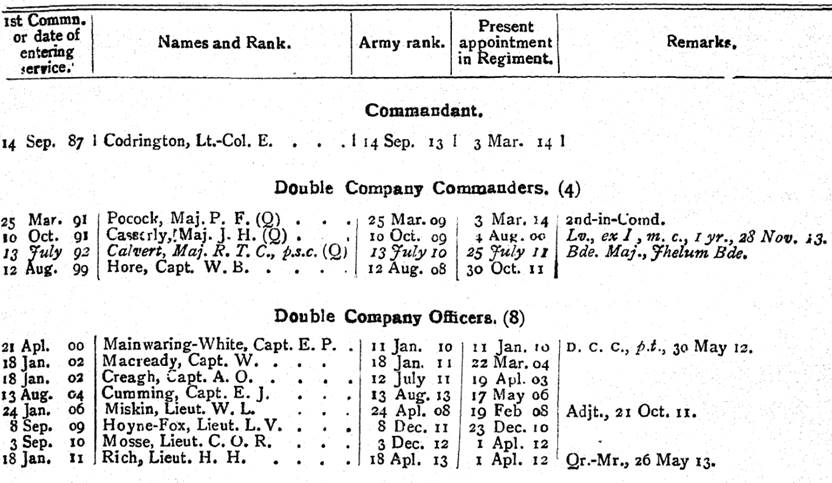This article on the 120th Rajputana Infantry will provide you with an overview of the Regiment’s service during the First World War and help you research those who served with it. I have written a series of guides to help you research soldiers who served in the Indian Army during the war. To view the guides click on the link below:
The 120th Rajputana Infantry in the First World War
Lineage: Raised by Lieutenant Colonel D. S. Fallon at Baroda (Vadodara), as the 2nd Battalion, 10th Regiment of Bombay Native Infantry in 1817, it became the 20th Regiment of Bombay Native Infantry in 1824. Then the 20th Regiment of Bombay Infantry in 1885, the 20th Bombay Infantry in 1901, the 120th Rajputana Infantry in 1903 and the 2nd Battalion 6th Rajputana Rifles in 1922.
Composition in 1914: 2 Companies of Rajputana Gujars, 2 Companies of Mers, 2 Companies of Rajputana Rajputs and 2 Companies of Hindustan Musalmans. 1919: 1 Company of Rajputana Rajputs, 1 Company of Rajputana Gujars, 1 Company of Mers and 1 Company of Hindustani Musalmans.
Location in July 1914: The 120th Rajputana Infantry was stationed at Belgaum (Belagavi, Karnataka, India) having arrived from Dibrugarh (Assam, India) on 6th April 1911.
The 120th Rajputana Infantry was stationed at Belgaum when the First World War began in August 1914. Earlier in the year, the Regiment had been inspected by Lieutenant-General Sir Arthur Arnold Barrett, Commanding 6th (Poona) Division in 1914 who reported:
Satisfactory progress has been made during the year in field training, which is now up to the average, but is still capable of improvement. The special attention of the new Commandant should be given to the points brought to notice by the Brigade Commander. This is a fine, smart battalion, well drilled and discipline, and fit for field service.
Confidential review reports on Indian Army units for 1913-1914: IOR/L/MIL/7/17023.
The extract below was taken from the October 1914 Indian Army List which recorded the British officers serving with the Regiment.
War Diary of the 120th Rajputana Infantry
There is only one war diary for the 120th Rajputana Infantry which has been digitized and can be downloaded from the National Archives’ website. To download the war diary for a small fee click on the blue link below. I have transcribed some of the entries below.
- Date: 06 November 1914 – 31 October 1915
- 18th Infantry Brigade, 6th (Poona) Division, Mesopotamia
- Reference: WO 95/5124/5
- Notes: A good war diary, though during the summer of 1915 many entries are very brief with “In Camp” typical. There are detailed entries for each of the battles the 120th Rajputana Infantry took part in. The only appendix is an Operation Order No.1 dated 16 November 1914 written on notepaper.
Further Sources for the 120th Rajputana Infantry
If you are researching British and Indian officers who served with the 120th Rajputana Infantry the Indian Army List should be consulted. A very good resource, particularly for the British officers who served with the Regiment is its annual confidential reports held at the British Library: Confidential Reports on Regiments etc. These confidential reports contain the annual reports of the British officers who were serving with the Regiment. However, when the 120th Rajputana Infantry was abroad only its Depot and the British officers who served with it are reported on. There is a list of Indian ranks of the Regiment taken prisoner by the Turks during the war held at the British Library but I can’t find the catalogue reference!
The National Army Museum has a diary of Lieutenant Charles Moss who served with the Regiment and four pages can be read online: Manuscript diary of Lieutenant Charles Mosse. There is also a regimental history: The History of the 2/6th Rajputana Rifles (Prince of Wales’ Own) by H. G. Rawlinson. If you’d like to learn more about the Siege of Kut I can recommend Kut 1916: Courage and Failure in Iraq by Patrick Crowley.
Extracts from War Diary of the 120th Rajputana Infantry
06 November 1914 – 31 October 1915, Mesopotamia, WO 95/5124/5
06 November 1914 – Bombay – Embarked at Bombay on two B.I. ships Erinpura and Ekma. Half Battalion in each.
18 November 1914 – Sahil – Information received that 4 men of a guard left behind at Saniyeh had been drowned in a storm while embarking baggage.
12 – 31 December 1914 – Mazeera – Remained in camp. On the nights of 20, 21, 22 and 23 the camp was sniped at night by Arabs. Subedar-Major Khital Ghul lay out in the plain on the night of the 23 with 60 men, and surprised the snipers. This caused a cessation of the sniping.
07 January 1915 – Tigris Camp – Captain C. P. Mainwaring- White and 100 men went at about midday for reconnaissance. The enemy (Arabs) appeared suddenly and fired over the party. One man wounded and 12 rifles lost. No. 1566 Sepoy Hukam Singh recommended for a reward for returning under fire to help a comrade (who could not swim) across a creek.
10 January 1915 – Tigris Camp – Captain E. P Mainwaring- White went out with a company to try and recover some of the rifles lost in the creek on the 7th instant. 8 rifles were recovered.
